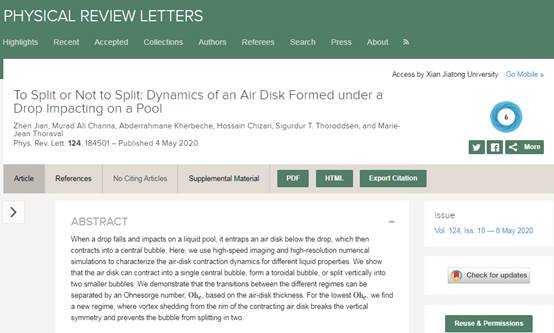
液滴撞击液池这一简单现象,几个世纪以来一直吸引着科学家们并给他们带来挑战。从雨滴溅起水花到喷墨3D打印增材制造技术,液滴撞击过程广泛存在于自然界和人类社会生产实践中。近年来,借助于高速摄像实验技术和超高精度数值模拟,科学家们开始了解这一微小尺度快速物理现象的更多细节。其中,液滴和液池聚并过程中,在液滴底部会发生气体捕获并形成一个只有微米级厚度的空气圆盘。
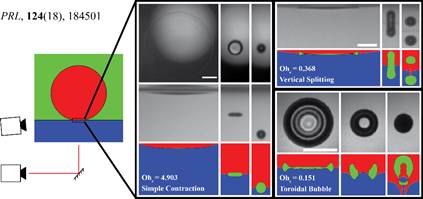

西安交通大学航天航空学院由Marie-Jean Thoraval教授领衔的国际化团队与沙特国王科技大学(KAUST) Sigurdur T. Thoroddsen教授展开合作,结合理论、实验及数值计算,研究了该空气盘的复杂收缩过程,揭示了众多迷人的动力学细节。如同敏捷的舞者,空气盘可以展现出不同姿态,或收缩成单一中心气泡,或形成环形气泡,抑或垂直分裂成两个更小的子气泡。而气泡一分为二与否,则主要取决于表面能的粘性耗散。研究者揭示了一种有趣的新机制,空气盘边缘可以像鱼尾一样上下摆动。高精度数值计算表明,从空气盘边缘自由表面脱落的涡,涡量正负交替变换,展现出复杂的精细微结构,如同跳一支复杂的舞蹈。同时,涡的生成吸收了能量,阻止了气泡的分裂。此外,气泡大小分布决定了气泡从液面溢出过程,该溢出过程存在于众多实际现象中。例如,对自然界生物物质扩散起至关重要作用的气溶胶,气泡溢出过程可以影响气溶胶的大小分布,进而影响人类健康,甚至导致云的形成,产生降雨,进一步构成完整的大气环境水气循环。
该研究成果以 “To Split or Not to Split: Dynamics of an Air Disk Formed under a Drop Impacting on a Pool”为题发表于物理学顶级学术期刊《物理评论快报》 (PHYSICAL REVIEW LETTERS,影响因子:9.227)。该文作者来自于中国、巴基斯坦、摩洛哥、伊朗、冰岛、法国等六个不同国家。第一作者菅振为西安交通大学航天航空学院助理教授;第二作者Murad Ali Channa为西安交通大学航天航空学院硕士研究生;第三作者Abderrahmane Kherbeche和第四作者Hossain Chizari为西安交通大学航天航空学院助理研究员;第五作者Sigurdur T. Thoroddsen为沙特国王科技大学(KAUST)教授;唯一通讯作者为西安交通大学航天航空学院Marie-Jean Thoraval教授。
该研究在西安交通大学Marie-Jean Thoraval教授负责的高速多相流实验室进行,该实验室建设获得西安交通大学和机械结构强度与振动国家重点实验室的支持,实验室中先进的高速摄影系统是该研究得以顺利开展的前提。另外,在本次项目中,菅振获得国家自然科学基金项目(11802226)资助;留学生Murad Ali Channa获得西安交通大学奖学金资助; Marie-Jean Thoraval教授获得国家自然科学基金项目(11542016,11702210,11850410439)、项目B18040和唐仲英基金会的共同资助。
航天航空学院历来重视基础研究。近一年来,固体力学、动力学与控制、流体力学分别在《物理评论快报》发表论文,力学三个主要二级学科齐头并进,基础研究,成果频出。
Jian, Z., Channa, M. A., Kherbeche, A., Chizari, H., Thoroddsen, S. T., & Thoraval*, M.-J. (2020). To Split or Not to Split: Dynamics of an Air Disk Formed under a Drop Impacting on a Pool. Physical Review Letters, 124(18), 184501.
论文链接:https://doi.org/10.1103/PhysRevLett.124.184501
Marie-Jean Thoraval教授个人主页:http://gr.xjtu.edu.cn/web/mjthoraval
The team of Professor Marie-Jean Thoraval from the School of Aerospace in Xi’an Jiaotong University has published a paper in the journal “PHYSICAL REVIEW LETTERS”
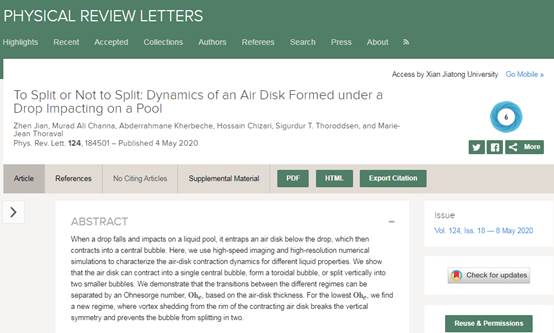
The simple impact of a drop onto a pool has fascinated and challenged scientists for centuries. From raindrops splashing to ink-jet 3D printing, droplet impact is widely involved in nature and industry. The details of the very rapid dynamics have only recently begun to be understood with the latest high-speed imaging and super-resolution numerical simulations. One aspect of the forced merger of the drop and pool is the entrapment of a micro-meter thick disc of air under the bottom of the drop.
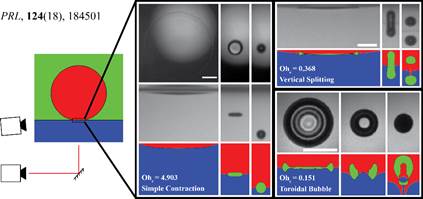
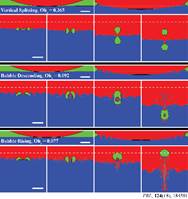
The international team led by Professor Marie-Jean Thoraval from the School of Aerospace of Xi'an Jiaotong University, in collaboration with Professor Sigurdur T. Thoroddsen from King Abdullah University of Science & Technology (KAUST) in Saudi Arabia, investigated the air entrapment process by theoretical, experimental and numerical methods. The complicated contraction of this air disk has revealed fascinating new dynamics. Whether the bubble splits in two or stays intact depends primarily on the viscous dissipation of the surface energy, but an intriguing new mechanism has emerged, where the edge of the disc flaps up and down like a fish-tail. Here the numerics reveal an intricate dance of alternating vortices shed from the free-surface rim during the contraction, thereby absorbing energy to prevent the bubble from splitting. The size-distribution of the entrapped bubbles determines how they subsequently pop at the pool surface, which in turn influences the size of aerosols of importance to dispersal of biological material, which affect human health and even leads to cloud formation, producing new drops to close the cycle.
The results, titled "To Split or Not to Split: Dynamics of an Air Disk Formed under a Drop Impacting on a Pool", were published in the top journal of physics, PHYSICAL REVIEW LETTERS (impact factor: 9.227). The authors originally come from six different countries as China, Pakistan, Morocco, Iran, Iceland and France. They are: Dr. Zhen Jian, Assistant Professor from the School of Aerospace, Xi'an Jiaotong University; Murad Ali Channa, Master’s degree from the School of Aerospace, Xi'an Jiaotong University; Dr. Abderrahmane Kherbeche and Dr. Hossain Chizari, Postdoctoral researchers from the School of Aerospace, Xi'an Jiaotong University; Professor Sigurdur T. Thoroddsen from KAUST; the corresponding author is Professor Marie-Jean Thoraval, from the School of Aerospace, Xi'an Jiaotong University.
The research was carried out in the High-speed Multiphase Flow Laboratory lead by Professor Marie-Jean Thoraval of Xi'an Jiaotong University. The construction of the laboratory was supported by Xi'an Jiaotong University and the State Key Laboratory for Strength and Vibration of Mechanical Structures. The cutting-edge high-speed imaging system in the laboratory is the premise of the realization of the research. In addition, Zhen Jian acknowledges the financial support from the National Natural Science Foundation of China (Grant No. 11802226). Marie-Jean Thoraval acknowledges the financial support from the National Natural Science Foundation of China (Grants No. 11542016, No. 11702210 and No. 11850410439) and the Project No. B18040. Marie-Jean Thoraval is also supported by the Cyrus Tang Foundation through the Tang Scholar program. Murad Ali Channa was supported by the Xi’an Jiaotong University Scholarship.
Jian, Z., Channa, M. A., Kherbeche, A., Chizari, H., Thoroddsen, S. T., & Thoraval*, M.-J. (2020). To Split or Not to Split: Dynamics of an Air Disk Formed under a Drop Impacting on a Pool. Physical Review Letters, 124(18), 184501.
DOI of the paper: https://doi.org/10.1103/PhysRevLett.124.184501
Website of Professor Marie-Jean Thoraval: http://gr.xjtu.edu.cn/web/mjthoraval